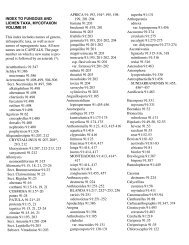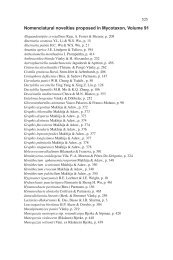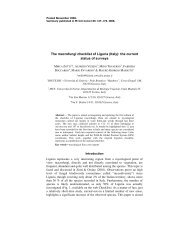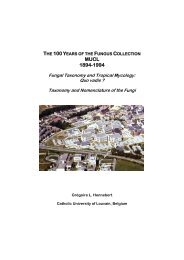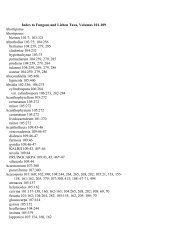download full review [pdf] - Mycotaxon
download full review [pdf] - Mycotaxon
download full review [pdf] - Mycotaxon
Create successful ePaper yourself
Turn your PDF publications into a flip-book with our unique Google optimized e-Paper software.
<strong>Mycotaxon</strong> 110 Book Reviews ... 545<br />
Foliicolous species belong to various higher taxonomic units of lichenized<br />
fungi, and systematically are very diverse. Of the more than 800 species so<br />
far described, 616 are found in the Neotropics. These are treated here in a<br />
systematic order, but an alphabetical index of scientific names of taxa is added.<br />
A large proportion of the species known in the world today are included in the<br />
artificial keys, and further natural keys to higher taxonomic units are provided.<br />
Although not all species known worldwide are included in the keys, material<br />
outside the Neotropics is considered when characterising their ecology and<br />
distribution. Furthermore, descriptions of orders, families, and genera are based<br />
on all members of the group, even including non-foliicolous representatives.<br />
The number of infraspecific taxa used and newly described in the monograph<br />
is relatively high compared to the usual number in recent treatments. However,<br />
one must agree with the author – who regards them as a temporary position<br />
for these particular taxa – that more information is required to justify the<br />
real taxonomic rank of many. There are an enormous number of taxonomic<br />
novelties published in the volume, including new taxa, combinations, and<br />
synonymies. There is a numerical list of taxa (pp. 819–829) amongst which<br />
are the new family Lyrommataceae and four new genera, Baflavia, Brasilicia,<br />
Eugeniella, and Phyllogyalidea. The first three of these genera originate from<br />
the former Bacidia s. lat., while Phyllogyalidea is separated from Gyalidea s. lat.<br />
A new section, Badimia sect. Pseudogyalecta, is also established. No fewer than<br />
60 new species and 13 new infraspecific taxa are also described here for the<br />
first time, and 35 new combinations are also made – and not all for taxa which<br />
occur in the neotropics. The name Strigula tremens is also reintroduced, and<br />
ten new taxonomic synonymies established amongst which are three recently<br />
described names.<br />
As the new taxa are deposited in several herbaria (including private herbaria)<br />
of the world, it would have been convenient to have a list of these (perhaps with<br />
information as to their accessibility) in the chapter on Materials.<br />
A <strong>review</strong> would not be complete without mentioning some details that<br />
could have been improved. It was difficult to find any such matters in this<br />
case, but perhaps it is worth mentioning that coloured photographs would<br />
have been highly appreciated by lichenologists instead of only half-tone black<br />
and whites. Foliicolous lichens, as many other lichens, are very colourful, and<br />
although half-tones show their great diversity of form, the diversity represented<br />
in their colours is missing. This is particularly so as colours can contribute to<br />
the successful identification of species. The drawings have been executed with<br />
great care, but unfortunately are not all are in the same style. In particular, some<br />
of the sketches look very different from others (e.g. spore illustrations) – most<br />
probably because the lines are thicker on the sketches (e.g. Figs 26 and 29) than<br />
on the other figures. A great advantage for comparisons is that the scale for


![download full review [pdf] - Mycotaxon](https://img.yumpu.com/5381692/37/500x640/download-full-review-pdf-mycotaxon.jpg)
